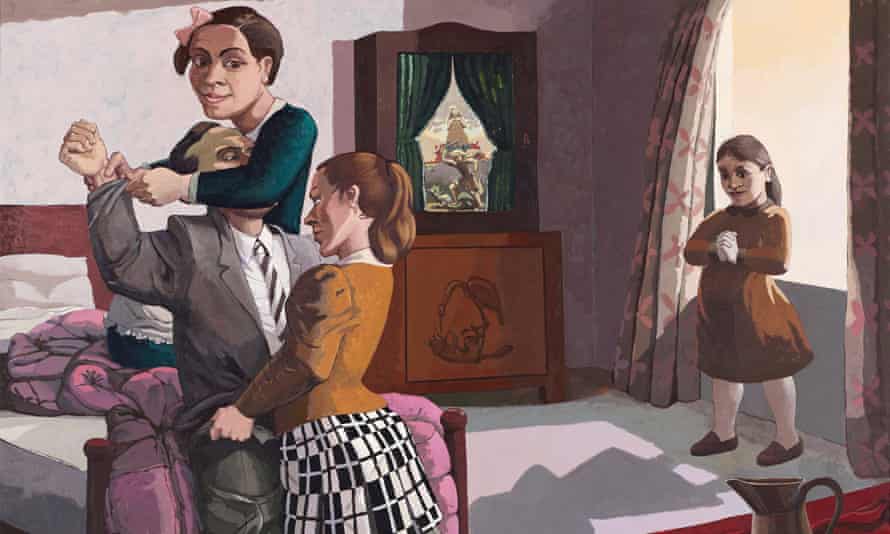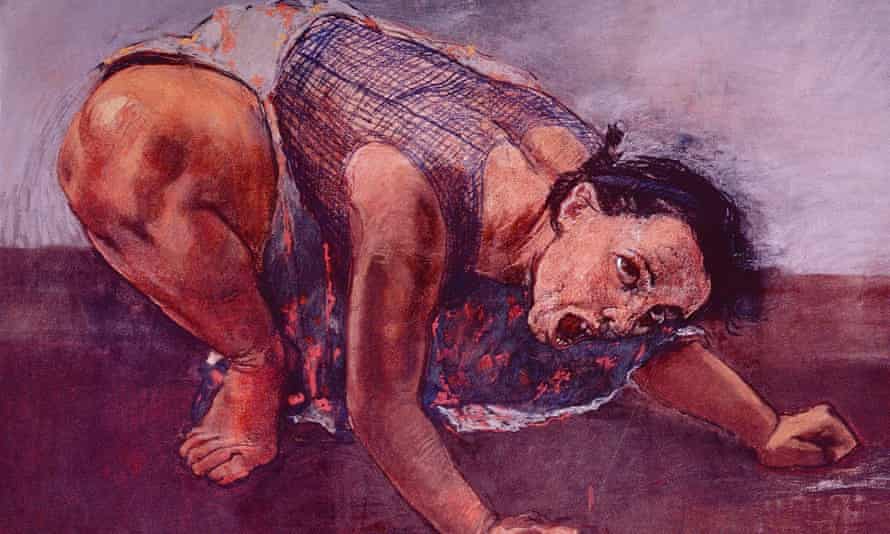 |
| Paula Rego |
Artist Paula Rego, known for her visceral and unsettling work, dies aged 87
‘She could make anything part of a story’ / What Paula Rego chose to paint and why
Geneva Abdul and Ashifa Kassam
Wed 8 Jun 2022 15.53 BST
The Victoria Miro gallery announced Rego’s death on Wednesday, saying: “She died peacefully this morning, after a short illness, at home in north London, surrounded by her family. Our heartfelt thoughts are with them.”
The painter, who recently had a retrospective exhibition at Tate Britain, rose to prominence after exhibiting with the London Group in the 1960s alongside David Hockney. In the following years she spent her career focusing on women’s rights, and abortion in particular.
Having grown up in a privileged family in Portugal under António de Oliveira Salazar’s fascist dictatorship, Rego was fascinated by fairytales, and her political paintings span themes of power, possession, childhood and sexual transgression.
In an interview with the Guardian in 2019, Rego, who had previously spoken about her own abortions, said that “making abortions illegal is forcing women to the backstreet solution”.
She added: “I’m doing what I can with my work but both men and women need to stand up to this. It affects men, too. You don’t get pregnant on your own, do you?”
Rego, an only child, was born in Lisbon in 1935. Her father, José, worked as an electronics engineer, and her mother, Maria, studied art but never practised as an artist.

Following a TB diagnosis at the age of three and at a doctor’s advice to leave Lisbon, Rego’s parents built a house in Estoril, where she lived surrounded by trees and sea air, as well as her grandparents’ summer house in Ericeira. In her early years, Rego was cared for by her grandmother and an aunt, as her parents lived in England where her father worked.
Beginning drawing from the age of four to “entertain herself”, Rego knew she wanted to be an artist by the age of eight, despite discouragement from teachers. Later sent to England, Rego said her parents “gave me everything”.
“They gave us a place to live and supported us for as long as they could. They looked after the children. They had faith in my work,” said Rego.
Known primarily for her subversive paintings, pastel drawing and prints inspired by folklore, Rego became the first associate artist in the National Gallery, which solidified her place as one of Britain’s greatest living painters and figurative artists worldwide. In 2010, she was made Dame by the Queen and described the honour as a “great recognition”.

Her work is valued in the millions of pounds, a film has been made about her, and a gallery named Casa das Histórias: Paula Rego (House of Stories), in the coastal town of Cascais, outside Lisbon, is one of the few dedicated to a living artist. But it was not until 1987 that Rego had her first major exhibition in Britain.
Having studied at the Slade School of Fine Art at 17 under Lucian Freud, Rego met the artist Victor Willing, who later became her husband. Falling pregnant at 20, she returned to Portugal which she described akin to “going back to prison, to a bourgeois life I detested”. In 1963, the couple bought a house in London’s Camden Town, and spent summers in Portugal.
After Slade, Rego said she “seized up and got into a terrible depression. I couldn’t keep following the rules; I had to break out”. In 1965, her first solo show in Lisbon was praised for its startling freedom of expression. In 1966, Willing was diagnosed with multiple sclerosis; he died in 1988. A year later, Rego was shortlisted for the Turner prize.
Some of Rego’s most highly regarded work was inspired by her relationship with Willing. In The Family (1998) shows a woman and her daughter dressing a seated man unable to help himself.
In her Tate Britain retrospective, placing Rego among a handful of contemporary female artists who have achieved comparable status, other notable works included the Dog Women series, a collection of pastel works portraying women behaving as dogs.
In Dog Woman (1994), inspired by a Portuguese fairytale, Rego asked her model Lila Nunes, the woman who had nursed her husband, to “crouch down and be a woman with her mouth open as she’s about to swallow something”.
Of her more political and eloquently shocking work, the harrowing abortion series depicts women doubled over after having had an illegal abortion. The works were created in response to an abortion referendum to liberalise Portuguese law in 1998, and was credited with helping sway public opinion.
Remembering her late husband, Rego previously told the Guardian: “Grief is always there, it doesn’t get easier. I thought about falling in love again many times, but that’s nobody’s business.”

After the announcement of Rego’s death, tributes started pouring in. “It is a national loss,” Portugal’s president, Marcelo Rebelo de Sousa, said on Wednesday. “For many decades Paula Rego was not just very important in Portugal and in England, where she lived and where I visited her in her studio in 2016, but rather throughout the world.”
In Cascais, officials said Thursday would be a day of mourning. “Portuguese culture has lost one of its most important and irreverent creators, someone who distinguished herself as a woman, human being and artist,” the mayor, Carlos Carreiras, said.
Tate art gallery’s director, Maria Balshaw, described Rego as an “incredible important figure” to Tate, and described holding her retrospective last year as a “true privilege”.
“She was an uncompromising artist of extraordinary imaginative power, who uniquely revolutionised the way in which women’s lives and stories are represented,” said Balshaw. “For many, many women, including myself and countless colleagues at Tate, she was the greatest of trailblazers and a vivid personal inspiration.”
When Rego was asked in 2021 what continued to matter most to her in her work, she curtly replied: “Simply doing it matters.”
Rego is survived by three children, whom she and her husband raised in Ericeira, Portugal, and, later, in London, and five granddaughters.


No comments:
Post a Comment